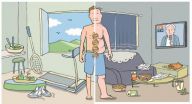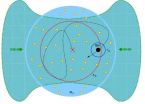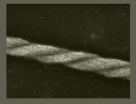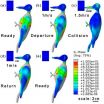(Press-News.org) Blood stem cells have the potential to turn into any type of blood cell, whether it be the oxygen-carrying red blood cells, or the many types of white blood cells of the immune system that help fight infection. How exactly is the fate of these stem cells regulated? Preliminary findings from research conducted by scientists from the Weizmann Institute and the Hebrew University are starting to reshape the conventional understanding of the way blood stem cell fate decisions are controlled thanks to a new technique for epigenetic analysis they have developed. Understanding epigenetic mechanisms (environmental influences other than genetics) of cell fate could lead to the deciphering of the molecular mechanisms of many diseases, including immunological disorders, anemia, leukemia, and many more. It also lends strong support to findings that environmental factors and lifestyle play a more prominent role in shaping our destiny.
The process of differentiation – in which a stem cell becomes a specialized mature blood cell – is controlled by a cascade of events in which specific genes are turned "on" and "off" in a highly regulated and accurate order. The instructions for this process are contained within the DNA itself in short regulatory sequences. These regulatory regions are normally in a "closed" state masked by special proteins called histones to ensure against unwarranted activation. Therefore, to access and "activate" the instructions, this DNA mask needs to be "opened" by epigenetic modifications of the histones so it can be read by the necessary machinery.
In a paper published in Science, Dr. Ido Amit and David Lara-Astiaso of the Weizmann Institute's Immunology Department, together with Prof. Nir Friedman and Assaf Weiner of the Hebrew University of Jerusalem, charted for the first time histone dynamics during blood development. Thanks to the new technique for epigenetic profiling they developed, in which just a handful of cells – as few as 500 – can be sampled and analyzed accurately, they have identified the exact DNA sequences, as well as the various regulatory proteins, that are involved in regulating the process of blood stem cell fate.
Their research has also yielded unexpected results: As many as 50% of these regulatory sequences are established and opened during intermediate stages of cell development. This means that epigenetics is active at stages in which it had been thought that cell destiny was already set. "This changes our whole understanding of the process of blood stem cell fate decisions," says Lara-Astiaso, "suggesting that the process is more dynamic and flexible than previously thought."
Although this research was conducted on mouse blood stem cells, the scientists believe that the mechanism may hold true for other types of cells. "This research creates a lot of excitement in the field, as it sets the groundwork to study these regulatory elements in humans," says Weiner. Discovering the exact regulatory DNA sequence controlling stem cell fate as well as understanding its mechanism hold promise for the future development of diagnostic tools, personalized medicine, potential therapeutic and nutritional interventions, and perhaps even regenerative medicine, in which committed cells could be reprogrammed to their full stem cell potential.
INFORMATION:
Dr. Ido Amit's research is supported by the M.D. Moross Institute for Cancer Research; the J&R Center for Scientific Research; the Jeanne and Joseph Nissim Foundation for Life Sciences Research; the Abramson Family Center for Young Scientists; the Wolfson Family Charitable Trust; the Abisch Frenkel Foundation for the Promotion of Life Sciences; the Leona M. and Harry B. Helmsley Charitable Trust; Sam Revusky, Canada; the Florence Blau, Morris Blau and Rose Peterson Fund; the estate of Ernst and Anni Deutsch; the estate of Irwin Mandel; and the estate of David Levinson. Dr. Amit is the incumbent of the Alan and Laraine Fischer Career Development Chair.
The Weizmann Institute of Science in Rehovot, Israel, is one of the world's top-ranking multidisciplinary research institutions. Noted for its wide-ranging exploration of the natural and exact sciences, the Institute is home to scientists, students, technicians and supporting staff. Institute research efforts include the search for new ways of fighting disease and hunger, examining leading questions in mathematics and computer science, probing the physics of matter and the universe, creating novel materials and developing new strategies for protecting the environment.
Weizmann Institute news releases are posted on the World Wide Web at http://wis-wander.weizmann.ac.il, and are also available at http://www.eurekalert.org.
Not only in DNA's hands
Epigenetics has a large say in blood formation
2014-08-11
ELSE PRESS RELEASES FROM THIS DATE:
All-you-can-eat at the end of the universe
2014-08-11
At the ends of the Universe there are black holes with masses equaling billions of our sun. These giant bodies – quasars – feed on interstellar gas, swallowing large quantities of it non-stop. Thus they reveal their existence: The light that is emitted by the gas as it is sucked in and crushed by the black hole's gravity travels for eons across the Universe until it reaches our telescopes. Looking at the edges of the Universe is therefore looking into the past. These far-off, ancient quasars appear to us in their "baby photos" taken less than a billion years after the Big ...
Nanocubes get in a twist
2014-08-11
Nanocubes are anything but child's play. Weizmann Institute scientists have used them to create surprisingly yarn-like strands: They showed that given the right conditions, cube-shaped nanoparticles are able to align into winding helical structures. Their results, which reveal how nanomaterials can self-assemble into unexpectedly beautiful and complex structures, were recently published in Science.
Dr. Rafal Klajn and postdoctoral fellow Dr. Gurvinder Singh of the Institute's Organic Chemistry Department used nanocubes of an iron oxide material called magnetite. As ...
How the woodpecker avoids brain injury despite high-speed impacts via optimal anti-shock body structure
2014-08-11
Designing structures and devices that protect the body from shock and vibrations during high-velocity impacts is a universal challenge.
Scientists and engineers focusing on this challenge might make advances by studying the unique morphology of the woodpecker, whose body functions as an excellent anti-shock structure.
The woodpecker's brain can withstand repeated collisions and deceleration of 1200 g during rapid pecking. This anti-shock feature relates to the woodpecker's unique morphology and ability to absorb impact energy. Using computed tomography and the construction ...
Megascale icebergs run aground
2014-08-11
Scientists from the Alfred Wegener Institute, Helmholtz Centre for Polar and Marine Research (AWI) have found between Greenland and Spitsbergen the scours left behind on the sea bed by gigantic icebergs. The five lineaments, at a depth of 1,200 metres, are the lowest-lying iceberg scours yet to be found on the Arctic sea floor. This finding provides new understanding of the dynamics of the Ice Age and the extent of the Arctic ice sheet thousands of years ago. In addition, the researchers could draw conclusions about the export of fresh water from the Arctic into the ...
Western Wall weathering: Extreme erosion explained
2014-08-11
Visitors to the Western Wall in Jerusalem can see that some of its stones are extremely eroded. This is good news for people placing prayer notes in the wall's cracks and crevices, but presents a problem for engineers concerned about the structure's stability.
The Western Wall is a remnant of the ancient wall that surrounded the courtyard of the Jewish Temple in Jerusalem. It is located in Jerusalem's Old City at the foot of the Temple Mount.
To calculate the erosion in the different kinds of limestone that make up the Western Wall, researchers from the Hebrew University ...
Celebrity promotion of charities 'is largely ineffective,' says research
2014-08-11
Celebrity promotion of charities is ineffective at raising awareness, but can make the stars more popular with the public, new research says.
According to journal articles by three UK academics, "the ability of celebrity and advocacy to reach people is limited" and celebrities are "generally ineffective" at encouraging people to care about "distant suffering".
The research, by Professor Dan Brockington, of The University of Manchester, Professor Spensor Henson, University of Sussex, and Dr Martin Scott, University of East Anglia, is published at time when many celebrities ...
A new cause of osteoarthritis identified by research on a rare disease
2014-08-11
A new mechanism of joint destruction caused by a natural material that grinds away healthy cartilage and worsens osteoarthritis has been identified in human hip joints for the first time by University of Liverpool scientists.
The scientists, with Professor Alan Boyde and colleagues from Queen Mary University of London, were studying the hip of a man with the genetic condition, alkaptonuria (AKU), This is a metabolic disease in which a substance called homogentisic acid accumulates in joint cartilage, causing changes to its physical properties.
The study revealed ...
Challenges and strategies for women pursuing STEM careers
2014-08-11
As a national push continues to recruit talented girls and young women into math and science-related careers, a new study underlines the importance of mentoring and other social support systems for women pursuing those research professions. Mary Jean Amon, a doctoral student in the University of Cincinnati's psychology program, will present her findings at the annual convention of the American Psychological Association in Washington, D.C.
Amon's study uncovered three themes that emerged as women examined the effects of gender stereotypes in STEM fields: career strategies, ...
Sensitive acid sensor controls insulin production
2014-08-11
This news release is available in German. Many human metabolic functions only run smoothly if the acid level in the body remains neutral and stable. For humans, normal blood pH values lie between 7.35 and 7.45. By way of comparison, an empty stomach is extremely acidic, with a pH value of 1.5.
The body constantly monitors this narrow pH band and quickly restores the ideal pH values in the event of any deviations. This is because many proteins cease to function properly if fluids in the body become even slightly more acidic. These proteins become unstable and alter ...
Testosterone in healthy men increases their brains' response to threat
2014-08-11
Philadelphia, PA, August 11, 2014 – Testosterone, a steroid hormone, is well known to contribute to aggressive behavior in males, but the neural circuits through which testosterone exerts these effects have not been clear.
Prior studies found that the administration of a single dose of testosterone influenced brain circuit function. Surprisingly, however, these studies were conducted exclusively in women.
Researchers, led by Dr. Justin Carré, sought to rectify this gap by conducting a study of the effects of testosterone on the brain's response to threat cues in healthy ...
LAST 30 PRESS RELEASES:
Post-stroke injection protects the brain in preclinical study
Cardiovascular risk score predicts multiple eye diseases
Health: estimated one in ten British adults used or interested in GLP-1 medications for weight loss
Exercise to treat depression yields similar results to therapy
Whooping cough vaccination for pregnant women strengthens babies’ immune system
Dramatic decline in new cases of orphanhood in Uganda driven by HIV treatment and prevention programs
Stopping weight loss drugs linked to weight regain and reversal of heart health markers
Higher intake of food preservatives linked to increased cancer risk
Mass General Brigham–developed cholera vaccine completes phase 1 trial
First experimental validation of a “150-year-old chemical common sense” direct visualization of the molecular structural changes in the ultrafast anthracene [4+4] photocycloaddition reaction
Lack of support for people on weight loss drugs leaves them vulnerable to nutritional deficiencies, say experts
Dogs’ dinners can have greater climate impact than owners’
Are you ready to swap salmon for sprats and sardines?
1.6 million UK adults used weight loss drugs in past year
American College of Cardiology comments on new dietary guidelines for Americans
American Society of Gene & Cell Therapy and Orphan Therapeutics Accelerator partner to advance and commercialize promising rare disease treatments
One in 14 patients having day case surgery have new or worse chronic pain 3 months after their operation
New study highlights link between eviction rates and gun violence
Heatwaves heat up soil but not toxin levels in rice, study finds
Digital modeling reveals where construction carbon emissions really come from
Turning farm waste into water filters
New study shows how the spleen helps the immune system accept a transplant
New Mayo Clinic study advances personalized prostate cancer education with an EHR-integrated AI agent
Researchers identify novel therapeutic target to improve recovery after nerve injury
Microbes in breast milk help populate infant gut microbiomes
Reprogramming immunity to rewrite the story of Type 1 diabetes
New tool narrows the search for ideal material structures
Artificial saliva containing sugarcane protein helps protect the teeth of patients with head and neck cancer
Understanding the role of linear ubiquitination in T-tubule biogenesis
Researchers identify urban atmosphere as primary reservoir of microplastics
[Press-News.org] Not only in DNA's handsEpigenetics has a large say in blood formation




